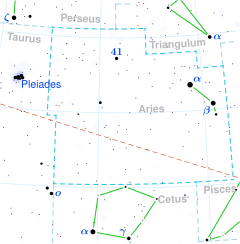Theta Arietis
| Observation data Epoch J2000 Equinox J2000 | |
|---|---|
| Constellation | Aries |
| Right ascension | 02h 18m 07.53022s[1] |
| Declination | +19° 54′ 04.1717″[1] |
| Apparent magnitude (V) | 5.58[2] |
| Characteristics | |
| Spectral type | A1 Vn[3] |
| U−B color index | +0.02[4] |
| B−V color index | +0.01[4] |
| Variable type | Constant[5] |
| Astrometry | |
| Radial velocity (Rv) | +6.0[2] km/s |
| Proper motion (μ) | RA: −7.491[1] mas/yr Dec.: −3.978[1] mas/yr |
| Parallax (π) | 7.6084 ± 0.1763 mas[1] |
| Distance | 429 ± 10 ly (131 ± 3 pc) |
| Absolute magnitude (MV) | −0.10[6] |
| Details | |
| A | |
| Mass | 2.10+0.37 −0.31 M☉[7] 2.94±0.06[8] M☉ |
| Radius | 1.9–2.5[9] R☉ |
| Luminosity | 106[6] L☉ |
| Surface gravity (log g) | 4.00±0.25[7] cgs |
| Temperature | 9,500±1,000[7] K |
| Rotational velocity (v sin i) | 186[10] km/s |
| Age | 107+286 −93[7] Myr |
| B | |
| Mass | 1.0+0.02 −0.04[7] M☉ |
| Temperature | 5,578±109[7] K |
| Metallicity [Fe/H] | 0.0[7] dex |
| Rotational velocity (v sin i) | 5[7] km/s |
| Other designations | |
| Database references | |
| SIMBAD | data |
Theta Arietis, Latinised from θ Arietis, is the Bayer designation for a binary star[7] system in the northern constellation of Aries. It is faintly visible to the naked eye with an apparent visual magnitude of 5.58.[2] With an annual parallax shift of 7.61 mas,[1] the distance to this star is an estimated 429 light-years (132 parsecs) with a 10-light-year margin of error. It is drifting further away with a radial velocity of +6 km/s.[2]
The primary, component A, is a white-hued, A-type main-sequence star with a stellar classification of A1 Vn.[3] It is spinning at a rapid pace as shown by the projected rotational velocity of 186 km/s.[10] This is causing the "nebulous" appearance of the absorption lines indicated by the 'n' suffix in the classification. In 2005, C. Neiner and associates classified this as a Be star because is displays emission features in the hydrogen Balmer lines.[5]
In 2016, a solar-mass companion was reported in close orbit around this star, based on observations using adaptive optics with the Gemini North Telescope.[7]
References
[edit]- ^ a b c d e f Brown, A. G. A.; et al. (Gaia collaboration) (August 2018). "Gaia Data Release 2: Summary of the contents and survey properties". Astronomy & Astrophysics. 616. A1. arXiv:1804.09365. Bibcode:2018A&A...616A...1G. doi:10.1051/0004-6361/201833051. Gaia DR2 record for this source at VizieR.
- ^ a b c d Wielen, R.; et al. (1999), "Sixth Catalogue of Fundamental Stars (FK6). Part I. Basic fundamental stars with direct solutions", Veroeffentlichungen des Astronomischen Rechen-Instituts Heidelberg, 35 (35), Astronomisches Rechen-Institut Heidelberg: 1, Bibcode:1999VeARI..35....1W.
- ^ a b Cowley, A.; et al. (April 1969), "A study of the bright A stars. I. A catalogue of spectral classifications", Astronomical Journal, 74: 375–406, Bibcode:1969AJ.....74..375C, doi:10.1086/110819.
- ^ a b Rybka, E. (1969), "The corrected magnitudes and colours of 278 stars near S.A. 1-139 in the UBV system", Acta Astronomica, 19: 229, Bibcode:1969AcA....19..229R.
- ^ a b Neiner, C.; et al. (February 2005), "The Identification of New Be Stars in GAUDI", The Astrophysical Journal Supplement Series, 156 (2): 237–243, Bibcode:2005ApJS..156..237N, doi:10.1086/426670, S2CID 123143757.
- ^ a b Anderson, E.; Francis, Ch. (2012), "XHIP: An extended hipparcos compilation", Astronomy Letters, 38 (5): 331, arXiv:1108.4971, Bibcode:2012AstL...38..331A, doi:10.1134/S1063773712050015, S2CID 119257644.
- ^ a b c d e f g h i j Gullikson, Kevin; et al. (August 2016), "The Close Companion Mass-ratio Distribution of Intermediate-mass Stars", The Astronomical Journal, 152 (2): 13, arXiv:1604.06456, Bibcode:2016AJ....152...40G, doi:10.3847/0004-6256/152/2/40, S2CID 119179065, 40.
- ^ Zorec, J.; Royer, F. (2012), "Rotational velocities of A-type stars. IV. Evolution of rotational velocities", Astronomy & Astrophysics, 537: A120, arXiv:1201.2052, Bibcode:2012A&A...537A.120Z, doi:10.1051/0004-6361/201117691, S2CID 55586789.
- ^ Pasinetti Fracassini, L. E.; et al. (February 2001), "Catalogue of Apparent Diameters and Absolute Radii of Stars (CADARS) - Third edition - Comments and statistics", Astronomy and Astrophysics, 367 (2): 521–524, arXiv:astro-ph/0012289, Bibcode:2001A&A...367..521P, doi:10.1051/0004-6361:20000451, S2CID 425754.
- ^ a b Royer, F.; Zorec, J.; Gómez, A. E. (February 2007), "Rotational velocities of A-type stars. III. Velocity distributions", Astronomy and Astrophysics, 463 (2): 671–682, arXiv:astro-ph/0610785, Bibcode:2007A&A...463..671R, doi:10.1051/0004-6361:20065224, S2CID 18475298.
- ^ "* tet Ari", SIMBAD, Centre de données astronomiques de Strasbourg, retrieved 2012-08-06.

